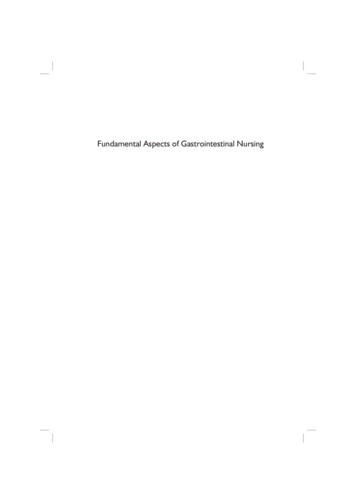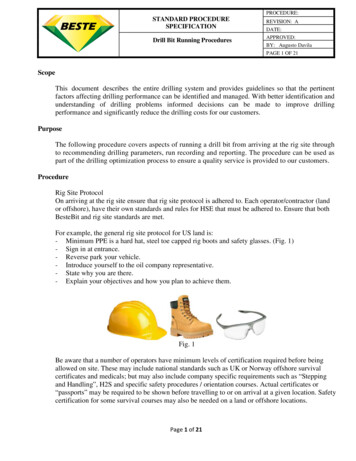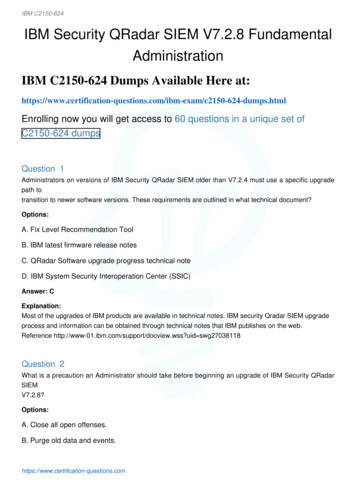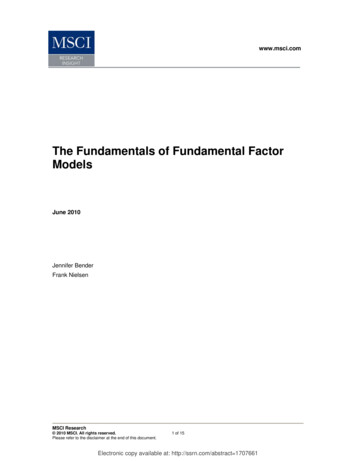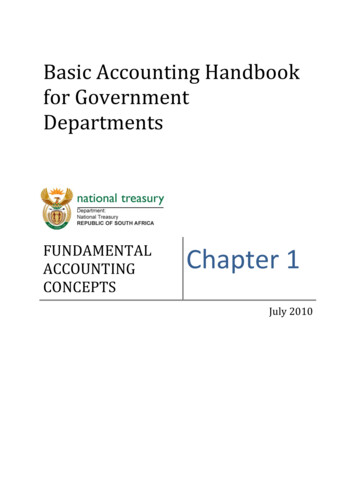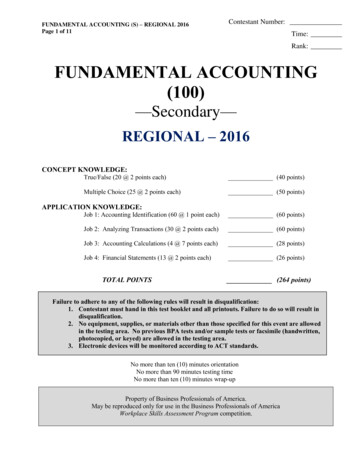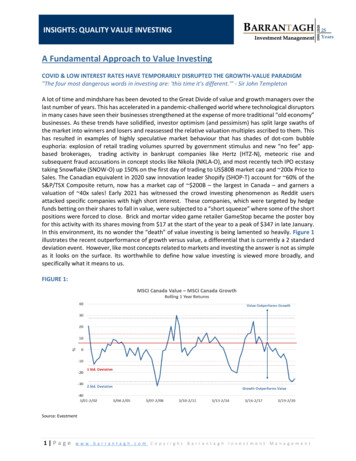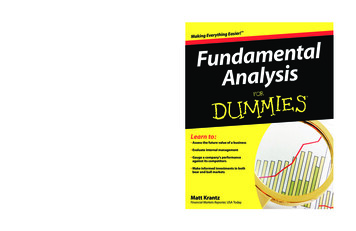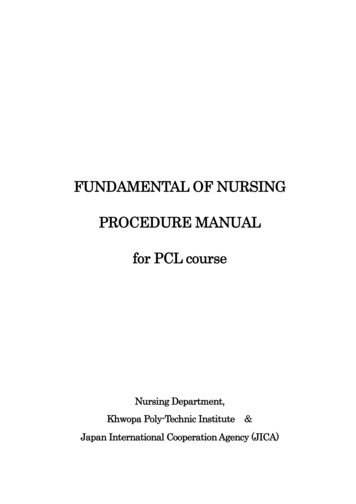
Transcription
FUNDAMENTAL OF NURSINGPROCEDURE MANUALfor PCL courseNursing Department,Khwopa Poly-Technic Institute &Japan International Cooperation Agency (JICA)
Fundamental of Nursing Procedure ManualPublished by:Japan International Cooperation Agency (JICA) Nepal OfficeBlock B, Karmachari Sanshaya Kosh BuildingHariharbhavan, Lalitpur, NEPAL(P.O. Box 450, Kathmandu, NEPAL)Tel:(977-1) 5010310Fax:(977-1) 5010284All copyright reserved by JICAFirst Edition: March, 2008Re - print:November, 20082
Fundamental of Nursing Procedure Manual Contributor:Sanjita KhadkaDurgeshori KisiPadma RayaSaphalta ShresthaEdited by Kei Miyamoto( Nursing Education, Senior Volunteer, JICA) Khwopa polytechnic institute, Nursing departmentPrinciple:Dr. Rajan SuwalFaculty members of Nursing DepartmentHead of Department : Sharmila ShresthaLecturer:Sanjita Khadka(1st year coordinator)Chitra Kala Sharma(2nd year coordinator)Merina Giri(3rd year coordinator)Bishnu UpretyAssistant lecturer:Durgeshori KisiPadma RayaSushila ChaudhariSunita BatasInstructor:Saphalta ShresthaSumitra BudhathokiSabitra KhadkaThank for contributing your professional knowledge and experience. We would like to appreciateto all our teachers and the former teachers, Ms. Junely Koju, Ms.Uttam Tara, and Ms. RashmiJoshi.3
Fundamental of Nursing Procedure ManualTable of ContentsI. Basic Nursing Care/ Skill7Bed makinga. Making an Un-occupied bedb. Changing an Occupied bedc. Making a Post-operative bed2. Performing oral carea. Assisting the client with oral careb. Providing oral care for dependent client3. Performing bed bath4. Performing back care5. Performing hair washing6. Care for fingernails/ toenails7. Performing perineal care8. Taking vital signsa. Taking axillary temperature by glass thermometerb. Measuring radial pulsec. Counting respirationd. Measuring blood pressure9. Performing physical examination10. Care for Nasal-gastric Tubea. Inserting a Nasal-Gastric Tubeb. Removal a Nasal-Gastric Tube11. Administering Nasal-Gastric tube feeding12. Cleaning a wound and Applying a sterile dressing13. Supplying oxygen inhalationa. Nasal Cannula Methodb. Mask Method: Simple face mask1.II. Administration of Medications1.2.3.4.5.6.7.8.9.10.Administering oral medicationsAdministering oral medications through a Nasal-Gastric TubeRemoving medications from an ampouleRemoving medications from a vialPrevention of the needle-stick injuriesGiving an Intra-muscular injectionStarting an Intra-venous infusionMaintenance of I.V. systemAdministering medications by Heparin LockPerforming Nebulizer Therapya. Inhalerb. Ultrasonic 8149
Fundamental of Nursing Procedure ManualIII. Specimen collection1.Collecting blood specimena. Performing venipunctureb. Assisting in obtaining blood for culture2.Collecting urine specimena. Collecting a single voided specimenb. Collecting a 24-hour urine specimenc. Collecting a urine specimen from a retention catheterd. Collecting a urine culture3. Collecting a stool specimen4. Collecting a sputum specimena. Routine testb. Collecting a sputum ndix171References1815
Fundamental of Nursing Procedure Manual6
Fundamental of Nursing Procedure ManualI. Basic Nursing Care/ Skill7
Fundamental of Nursing Procedure Manual8
Fundamental of Nursing Procedure ManualBed makinga. Making an Un-occupied BedDefinition:A bed prepared to receive a new patient is an un-occupied bed.Fig.1. Un-occupied bedPurpose1. To provide clean and comfortable bed for the patient2. To reduce the risk of infection by maintaining a clean environment3. To prevent bed sores by ensuring there are no wrinkles to cause pressure pointsEquipment required:1. Mattress (1)2. Bed sheets(2): Bottom sheet (1)Top sheet(1)3. Pillow(1)4. Pillow cover (1)5. Mackintosh (1)6. Draw sheet (1)7. Blanket(1)8. Savlon water or Dettol water in basin9. Sponge cloth (4): to wipe with solution (1)to dry(1) When bed make is done by two nurses,sponge cloth is needed two each.10. Kidney tray or paper bag (1)11. Laundry bag or Bucket (1)12. Trolley(1)Fig. 2. Equipment required on a trolley9
Fundamental of Nursing Procedure ManualProcedure: by one nurseCare Action1. Explain the purpose and procedure to the client.2. Perform hand hygiene.3. Prepare all required equipments and bring thearticles to the bedside.4. Move the chair and bed side locker5. Clean Bed-side locker:Wipe with wet and dry.Rationale Providing information fosters cooperation. To prevent the spread of infection. Organizationfacilitatesaccurateskillperformance It makes space for bed making and helps effectiveaction. To maintain the cleanliness6. Clean the mattress: To prevent the spread of infection1) Stand in right side.2) Start wet wiping from top to center and fromcenter to bottom in right side of mattress.3) Gather the dust and debris to the bottom.4) Collect them into kidney tray.5) Give dry wiping as same as procedure 2).6) Move to left side.7) Wipe with wet and dry the left side.7. Move to right side.Bottom sheet:1) Place and slide the bottom sheet upward over Unfolding the sheet in this manner allows you tothe top of the bed leaving the bottom edge of themake the bed on one side.sheet.2) Open it lengthwise with the center fold along thebed center.3) Fold back the upper layer of the sheet toward theopposite side of the bed.4) Tuck the bottom sheet securely under the head ofthe mattress(approximately 20-30cm). (Fig.3)Make a mitered corner. A mitered corner has a neat appearance and keepsthe sheet securely under the mattress.➀Pick up the selvage edge with your handnearest the hand of the bed.➁Lay a triangle over the side of the bed (Fig.4 )➂Tuck the hanging part of the sheet under the Tucking the bottom sheet will be done by turn,the corner of top firstly and the corner of themattress.( Fig. 5)bottom later.➃ Drop the triangle over the side of the bed.( Fig. 6 6 )⑤Tuck the sheet under the entire side of bed.(Fig. To secure the bottom sheet on one side of the bed.7)5) Repeat the same procedure at the end of thecorner of the bed6) Tuck the remainder in along the side8. Mackintosh and draw sheet: Mackintosh and draw sheet are additional1) Place a mackintosh at the middle of the bed ( ifprotection for the bed and serves as a lifting orused), folded half, with the fold in the center ofturning sheet for an immobile client.the bed. used), folded half, with the fold in thecenter of the bed.2) Lift the right half and spread it forward the nearSide.10
Fundamental of Nursing Procedure ManualFig.3 Tuck the bottom sheet under the mattressFig.6a Putting and holding the sheet bedside themattress at the level of topFig.4 Picking the selvage and laying a triangle onthe bedFig.6b Dropping the triangle over the side of the bedFig.5 Tucking the hanging part of the sheet underthe mattressFig.7 Tucking the sheet under the entire side of thebed11
Fundamental of Nursing Procedure ManualCare Action3) Tuck the mackintosh under the mattress.4) Place the draw sheet on the mackintosh. Spreadand tuck as same as procedure 1)-3).9.Move to the left side of the bed.Bottom sheet , mackintosh and draw sheet:1) Fold and tuck the bottom sheet as in the aboveprocedure 7.2) Fold and tuck both the mackintosh and the drawsheet under the mattress as in the aboveprocedure 8.10. Return to the right side.Top sheet and blanket:1) Place the top sheet evenly on the bed, centeringit in the below 20-30cm from the top of themattress.2) Spread it downward.3) Cover the top sheet with blanket in the below 1feet from the top of the mattress and spreaddownward.4) Fold the cuff (approximately 1 feet) in the neckpart5) Tuck all these together under the bottom ofmattress. Miter the corner.6) Tuck the remainder in along the side11. Repeat the same as in the above procedure 10 inleft side.12. Return to the right side.Pillow and pillow cover:1) Put a clean pillow cover on the pillow.Rationale Secure the bottom sheet, mackintosh and drawsheet on one side of the bed A blanket provides warmth. Making the cuff at the neck part preventsirritation from blanket edge. Tucking all these pieces together saves time andprovides a neat appearance. To save time in this manner A pillow is a comfortable measure. Pillow cover keeps cleanliness of the pillow andneat.2) Place a pillow at the top of the bed in the center The open end may collect dust or organisms.with the open end away from the door. The open end away from the door also makesneat.13. Return the bed, the chair and bed-side table to Bedside necessities will be within easy reach fortheir proper place.the client .14. Replace all equipments in proper place. It makes well-setting for the next.Discard lines appropriately. Proper line disposal prevents the spread ofinfection.15. Perform hand hygiene To prevent the spread of infection. Nursing Alert Do not let your uniform touch the bed and the floor not to contaminate yourself. Never throw soiled lines on the floor not to contaminate the floor. Staying one side of the bed until one step completely made saves steps and time to do effectively andsave the time.12
Fundamental of Nursing Procedure ManualBed makingb. Changing an Occupied BedDefinitionThe procedure that used lines are changed to a hospitalized patient is an occupied bed.Fig. 8 Occupied bedPurpose:1. To provide clean and comfortable bed for the patient2. T reduce the risk of infection by maintaining a clean environment3. To prevent bed sores by ensuring there are no wrinkles to cause pressure pointsEquipment required:1. Bed sheets(2) : Bottom sheet( or bed cover) (1)Top sheet(1)2. Draw sheet (1)3. Mackintosh (1) (if contaminated or needed to change)4. Blanket(1) ( if contaminated or needed to change)5. Pillow cover (1)6. Savlon water or Dettol water in bucket7. Sponge cloth (2): to wipe with solution (1)to dry(1) When the procedure is done by two nurses, sponge cloth is needed two each.8. Kidney tray or paper bag (1)9. Laundry bag or bucket (1)10. Trolley(1)13
Fundamental of Nursing Procedure ManualProcedure: by one nurseCare Action1. Check the client’s identification and condition.2. Explain the purpose and procedure to the client3. Perform hand hygiene4. Prepare all required equipments and bring thearticles to the bedside.5. Close the curtain or door to the room. Put screen.6. Remove the client’s personal belongings frombed-side and put then into the bed-side locker orsafe place.7. Lift the client’s head and move pillow from centerto the left side.8. Assist the client to turn toward left side of thebed. Adjust the pillow. Leaves top sheet in place.Rationale To assess necessity and sufficient condition Providing information fosters cooperation To prevent the spread of infection. Organization facilitates accurate skill performance To maintain the client’s privacy. To prevent personal belongings from damage andloss. The pillow is comfortable measure for the client. Moving the client as close to the other side of thebed as possible gives you more room to make thebed. Top sheet keeps the client warm and protect his orher privacy.9.Stand in right side: Placing folded (or rolled) soiled linen close to theLoose bottom bed linens. Fanfold (or roll) soiled client allows more space to place the clean bottomlinens from the side of the bed and wedge them sheets.close to the client.10. Wipe the surface of mattress by sponge cloth To prevent the spread of infection.with wet and dry.11. Bottom sheet, mackintosh and draw sheet: Soiled linens can easily be removed and clean1) Place the clean bottom sheet evenly on the bed linens are positioned to make the other side of thefolded lengthwise with the center fold as close to bed.the client’s back as possible.2) Adjust and tuck the sheet tightly under the headof the mattress, making mitered the uppercorner.3) Tighten the sheet under the end of the mattressand make mitered the lower corner.4) Tuck in along side.5) Place the mackintosh and the draw sheet on thebottom sheet and tuck in them together.12. Assist the client to roll over the folded (rolled) Moving the client to the bed’s other side allows youlinen to right side of the bed. Readjust the pillow to make the bed on that side.and top sheet.13. Move to left side:Discard the soiled linens appropriately. Hold Soiled linens can contaminate your uniform,them away from your uniform. Place them in the which may come into contact with other clients.laundry bag (or bucket).14. Wipe the surface of the mattress by sponge cloth To prevent the spread of infection.with wet and dry.15. Bottom sheet, mackintosh and draw sheet:1) Grasp clean linens and gently pull them out from Wrinkled linens can cause skin irritation.under the client.2) Spread them over the bed’s unmade side. Pull thelinens taut14
Fundamental of Nursing Procedure ManualCare Action3) Tuck the bottom sheet tightly under the head ofthe mattress and miter the corner.4) Tighten the sheet under the end of the mattressand make mitered the lower corner.5) Tuck in along side.6) Tuck the mackintosh and the draw sheet underthe mattress.16. Assist the client back to the center of the bed.Adjust the pillow.17. Return to right side:Clean top sheet, blanket:1) Place the clean top sheet at the top side of thesoiled top sheet.2) Ask the client to hold the upper edge of the cleantop sheet.3) Hold both the top of the soiled sheet and the endof the clean sheet with right hand and withdrawto downward. Remove the soiled top sheet andput it into a laundry bag (or a bucket).4) Place the blanket over the top sheet. Fold topsheet back over the blanket over the client.5) Tuck the lower ends securely under the mattress.Miter corners.6) After finishing the right side, repeat the left side.18. Remove the pillow and replace the pillow coverwith clean one and reposition the pillow to thebed under the client’s head.19. Replace personal belongings back. Return thebed-side locker and the bed as usual.20. Return all equipments to proper place.Rationale The pillow is comfort measure for the client. Tucking these pieces together saves time andprovides neat, tight corners. The pillow is a comfortable measures for a client To prevent personal belongings from loss andprovide safe surroundings To prepare for the next procedure21. Discard linens appropriately. Perform hand To prevent the spread of infection.hygiene.15
Fundamental of Nursing Procedure ManualBed makingc. Making a Post-operative BedDefinition:It is a special bed prepared to receive and take care of a patient returning from surgery.Fig.9 Post-operative bedPurpose:1. To receive the post-operative client from surgery and transfer him/her from a stretcher to a bed2. To arrange client’s convenience and safetyEquipment required:1. Bed sheets: Bottom sheet (1)Top sheet (1)2. Draw sheet (1-2)3. Mackintosh or rubber sheet (1-2) According to the type of operation, thenumber required of mackintosh and drawsheet is different.4. Blanket (1)5. Hot water bag with hot water (104- 140 )if needed (1)6. Tray1(1)7. Thermometer,stethoscope,sphygmomanometer: 1 each8. Spirit swab9. Artery forceps (1)10. Gauze pieces11.12.13.14.15.16.17.Adhesive tape (1)Kidney tray (1)Trolley (1)IV standClient’s chartClient’s kardexAccording to doctor’s orders:- Oxygen cylinder with flow meter- O2 cannula or simple mask- Suction machine with suction tube- Airway- Tongue depressor- SpO2 monitor- ECG- Infusion pump, syringe pump16
Fundamental of Nursing Procedure ManualProcedure: by one nurseCare Action1. Perform hand hygiene2.Assemble equipments and bring bed-side3. Strip bed.Make foundation bed as usual with a largemackintosh, and cotton draw sheet.Rationale To prevent the spread of infection Organizationfacilitatesaccurateperformanceskill Mackintosh prevents bottom sheet from wettingor soiled by sweat, drain or excrement. Place mackintosh according to operativetechnique. Cotton draw sheet makes the client felt dry orcomfortable without touching the mackintoshdirectly.4. Place top bedding as for closed bed but do not Tuck at foot may hamper the client to enter thetuck at footbed from a stretcher5. Fold back top bedding at the foot of bed. (Fig.10 ) To make the client ‘s transfer smooth6. Tuck the top bedding on one side only. (Fig. 11 ) Tucking the top bedding on one side stops the bedlinens from slipping out of place and7. On the other side, do not tuck the top sheet. The open side of bed is more convenient forreceiving client than the other closed side.1) Bring head and foot corners of it at the center ofbed and form right angles. (Fig.12 )2) Fold back suspending portion in 1/3 (Fig. 13 )andrepeat folding top bedding twice to opposite sideof bed(Fig.14, 15)8. Remove the pillow. To maintain the airway9 Place a kidney-tray on bed-side. To receive secretion10. Place IV stand near the bed. To prepare it to hang I/V soon11. Check locked wheel of the bed. To prevent moving the bed accidentally when theclient is shifted from a stretcher to the bed.12.Place hot water bags(or hot bottles) in the Hot water bags (or hot bottles) prevent the clientmiddle of the bed and cover with fanfolded top iffrom taking hypothermianeeded13.When the patient comes, remove hot water bags To prepare enough space for receiving the clientif put before14. Transfer the client:1) Help lifting the client into the bed2) Cover the client by the top sheet and blanket To prevent the client from chilling and /or havingimmediatelyhypothermia3) Tuck top bedding and miter a corner in the end ofthe bed.17
Fundamental of Nursing Procedure ManualFig. 10 Folding back top bedding at the footFig. 13 Folding 1/3 side of top bedding at right sideFig. 11 Tucking the top bedding on left sideFig.14 Rolling top bedding againFig. 12 Bringing both head and foot corners to thecenter and forming right anglesFig. 15 Folding it again and complete top bedding18
Fundamental of Nursing Procedure ManualPerforming Oral CareDefinition:Mouth care is defined as the scientific care of the teeth and mouth.Purpose:1.2.3.4.5.6.To keep the mucosa clean, soft, moist and intactTo keep the lips clean, soft, moist and intactTo prevent oral infectionsTo remove food debris as well as dental plaque without damaging the gumTo alleviate pain, discomfort and enhance oral intake with appetiteTo prevent halitosis or relieve it and freshen the mouthEquipment required:1.2.3.4.Tray (1)Gauze-padded tongue depressor (1): to suppress tongueTorch(1)Appropriate equipments for cleaning:- Tooth brush- Foam swabs- Gauze-padded tongue depressor- Cotton ball with artery forceps (1) and dissecting forceps (1)5. Oral care agents:Tooth paste/ antiseptic solution NURSING ALERT You should consider nursing assessment, hospital policy and doctor’s prescription if there is,when you select oral care agent. Refer to Table 1. on the next page6. If you need to prepare antiseptic solution as oral care agent:Gallipot (2): to make antiseptic solution(1)to set up cotton ball after squeezed (1)7. Cotton ball8. Kidney tray (1)9. Mackintosh (1): small size10. Middle towel (1)11. Jug with tap water (1)12. Paper bag(2): for cotton balls (1)for dirt(1)13. Gauze pieces as required: to apply a lubricant14. Lubricants: Vaseline/ Glycerin/ soft white paraffin gel/ lip cream (1)15. Suction catheter with suction apparatus (1): if available16. Disposable gloves( 1 pair): if available19
Fundamental of Nursing Procedure ManualNOTE:Table 1. Various oral care agents for oral hygieneThe choice of an oral care agent is dependent on the aim of care. The various agents are available and shouldbe determined by the individual needs of the client.AgentsPotential benefitsPotential harmsTap water To refresh be available Short lasting not contain a bactericideTooth paste Not specified It can dry the oral cavity if notadequately rinsed *1 To remove debris To refreshNystatin To treat fungal infections Tastes unpleasantChlorhexidine gluconate:acompoundwith To suppress the growing of bacteria indoses of 0.01-0.2 % solution *2 not be significantto preventchemotherapy- induced mucositis *2 Tastes unpleasant be stainable teeth with prolonged usebroad-spectrumanti-microbial activity *2Sodium bicarbonate: To dissolve viscous mucous*3 Tastes unpleasant may bring burn if not dilutedadequately can alter oral pH allowing bacteria tomultiply *1Fluconazole:anorallyabsorbedantifungal azole, soluble in for the treatment of candidosis of theoropharynx, oesophagus and variety ofdeep tissue sites *3 not reportedInitially for the clients under radiotherapyand chemotherapy not reportedwaterSucralfate:a mouth-coating agent To reduce pain of mucositisFluoride To prevent and arrest tooth decay especiallyradiationcaries,demineralization and decalcification To show toxicity in high densityGlycerine an thymol To refresh Refreshing lasts only 20-30 seconds*1 Can over-stimulate the salivaryglands leading to reflex action andexhaustion *1Another solutions for oral care such as Potasium permanganate(1:5000), Sodium chloride(I teaspoon to a pint ofwater), Potasium chroride( 4 to 6 %), Hydrogen perpxide(1: 8 solution) are used commonly*4.References:1. Penelope Ann Hilton(2004) fundamental nursing skills , I.K. International Pvt. Ltd., 2.htm The Royal Marsden Hospital Manual ofClinical Nursing procedure, 6th edition, Personal hygiene: mouth x?ss 15&doc id 7153&nbr 4285Nursing management of oral hygiene, National Guideline Clearinghouse4. I Clement(2007) Basic Concepts on Nursing Procedures, Jaypee, p. 6820
Fundamental of Nursing Procedure Manuala. Assisting the client with Oral careProcedure:Care Action1.Explain the procedures 2. Collect all instruments required 3. Close door and /or put screen4. Perform hand hygiene and wear disposablegloves if possible5. If you use solutions such as sodium bicarbonate,prepare solutions required.6. Assist the client a comfortable upright position orsitting position RationaleProviding information fosters cooperation,understanding and participation in eTo maintain privacyTo prevent the spread of infection Solutions must be prepared each time before useto maximize their efficacy To promote his/her comfort and safety andeffectiveness of the care including oral inspectionand assessment7. Inspect oral cavity1) Inspect whole the oral cavity ,such as teeth, Comprehensive assessment is essential togums, mucosa and tongue, with the aid ofdetermine individual needsgauze-padded tongue depressor and torch2) Take notes if you find any abnormalities, e.g., Some clients with anemia, immunosuppression,bleeding, swollen, ulcers, sores, etc.diabetes, renal impairment epilepsy and takingsteroids should be paid attention to oral condition.They may have complication in oral cavity.8. Place face towel over the client chest or on the To prevent the clothing form wetting and not tothigh with mackintosh (Fig. 16)give uncomfortable condition9. Put kidney tray in hand or assist the client To receive disposal surelyholding a kidney trayFig16 Setting the kidney tray up with face towel covered mackintosh21
Fundamental of Nursing Procedure ManualCare Action10. Instruct the client to brush teethPoints of instruction1) Client places a soft toothbrush at a 45 angle tothe teeth.2) Client brushes in direction of the tips of thebristles under the gum line with tooth paste.Rotate the bristles using vibrating or jigglingmotion until all outer and inner surfaces of theteeth and gums are clean.3) Client brushes biting surfaces of the teeth4) Client clean tongue from inner to outer and avoidposterior direction.11. If the client cannot tolerate toothbrush (orcannot be available toothbrush), form swabs orcotton balls can be used12. Rinse oral cavity1) Ask the client to rinse with fresh water and voidcontents into the kidney tray.2) Advise him/her not to swallow water. If needed,suction equipment is used to remove any excess.13. Ask the client to wipe mouth and around it.14. Confirm the condition of client’s teeth, gums andtongue. Apply lubricant to lips.15. Rinse and dry tooth brush thoroughly. Returnthe proper place for personal belongings afterdrying up.16. Replace all instruments17. Discard dirt properly and safety18. Remove gloves and wash your hands19. Document the care and sign on the records.20. Report any findings to senior staffsRationale Effective in dislodging debris and dental plaquefrom teeth and gingival margin Cleansing posterior direction of the tongue maycause the gag reflex When the client is prone to bleeding and/or pain,tooth brush is not advisable To make comfort and not to remain any fluid anddebris To reduce potential for infection and To make comfort and provide the well-appearance To moisturize lips and reduce risk for cracking To prevent the growth of microorganisms To prepare equipments for the next procedureTo maintain standard precautionsTo prevent the spread of infectionDocumentation provides ongoing data collectionand coordination of care Givingsignaturemaintainsprofessionalaccountability To provide continuity of care22
Fundamental of Nursing Procedure Manualb. Providing oral care for dependent clientFig. 17 Equipments required for oral care in depending clientProcedure: The procedure with cotton balls soaked sodium bicarbonate is showed here.Care Action1. Check client’s identification and conditionRationale Providing nursing care for the correct client withappropriate way.2. Explain the purpose and procedure to the client Providing information fosters cooperation andunderstanding3.Perform hand hygiene and wear disposable gloves To prevent the spread of infection.4. Prepare equipments:1) Collect all required equipments and bring the Organizationfacilitatesaccurateskillarticles to the bedside.performance2) Prepare sodium bicarbonate solutions in gallipot. Solutions must be prepared each time before useto maximize their efficacy Nursing Alert To reduce potential infectionIf the client is unconscious, use plain tap water.3) Soak the cotton ball in sodium bicarbonates Cleaning solutions aids in removing residue onthe client’s teeth and softening encrusted areas.solution(3 pinches / 2/3 water in gallipot) withartery forceps.4) Squeeze all cotton balls excess solution by artery To avoid inspiration of the solutionforceps and dissecting forceps and put intoanother gallipot5. Close the curtain or door to the room. Put screen. It maintains the client’s privacy6. Keep the client in a side lying or in comfortable Proper positioning prevents back strainposition. Tilting the head downward encourages fluid todrain out of the client’s mort and it preventsaspiration.23
Fundamental of Nursing Procedure ManualCare ActionRationale7. Place the mackintosh and towel on the neck to The towel and mackintosh protect the client andchest.bed from soakage.8. Put the kidney tray over the towel and It facilitates drainage from the client’s mouth.mackintosh under the chin.(Fig. 18)9. Inspect oral cavity:1) Inspect whole the oral cavity, such as teeth, Comprehensive assessment is essential togums, mucosa and tongue, with the aid ofdetermine individual needs.gauze-padded tongue depressor and torch. Some clients with anemia, immunosuppression,2) Take notes if you find any abnormalities, e.g.,diabetes, renal impairment, epilepsy and takingbleeding, swollen, ulcers, etc.steroids should be paid attention to oral condition.They may have complication in oral cavity.10. Clean oral surfaces: (Fig.19)1) Ask the client to open the mouth and insert the The tong depressor assists in keeping the client’spadded tong depressor gently from the angle ofmouth open. As a reflex mechanism, the clientmouth toward the back molar area. You never usemay bite your fingers.your fingers to open the client’s mouth.2) Clean the client’s teeth from incisors to molars Friction cleanses the teeth.using up and down movements from gums tocrown.3) Clean oral cavity from proximal to distal, outer Friction cleanses the teeth.to inner parts, using cotton ball for each stroke.11. Discard used cotton ball into small kidney tray. To prevent the spread of infection.12. Clean tongue from inner to outer aspect. Microorganisms collect and grow on tonguesurface and contribute to bad breath.Fig.18 Placing a kidney tray on the mackintoshcovered a face towelFig. 19 Cleansing teeth with supporting paddedtongue depressor24
Fundamental of Nursing Procedure ManualCare Action13. Rinse oral cavity:1) Provide tap water to gargle mouth and positionkidney tray.2) If the client cannot gargle by him/herself,a) rinse the areas using moistened cotton ballsorb) insert of rubber tip of irrigating syringe intothe client’s mouth and rinse gently with a smallamount of water.3) Assist to void the contents into kidney tray. If theclient cannot spit up, especially in the case ofunconscious client, suction any solution.14. Confirm the condition of client’s teeth, gums,mucosa and tongue.15. Wipe mouth and around it. Apply lubricant tolips by using foam swab or gauze piece withartery forceps16. Reposition the client in comfortable position.17. Replace all equipments in proper place.18. Discard dirt properly and safety19. Remove gloves and perform hand hygiene20. Document the care and sign on the records.21. Report any findings to the senior staff.Rationale To remove debris and make refresh Rinsing or suctioning removes cleaning solutionand debris. Solution that is forcefully irrigated may causeaspiration To avoid aspiration of the solution To assess the efficacy of oral care and determineany abnormalities Lubricant prevents lips from drying and cracking. To provides for the client’s comfort and safety.To prepare equipm
Jun 25, 2010 · Fundamental of Nursing Procedure Manual 12 CareAction Rationale 3)Tuckthemackintoshunderthemattress. 4) Place the draw sheet on the mackintosh. Spread

